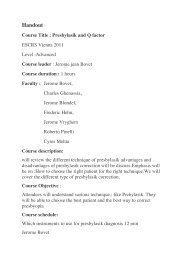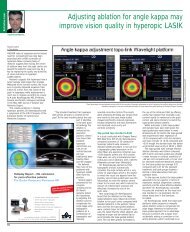ESCRS Guidelines on prevention, investigation and management of
ESCRS Guidelines on prevention, investigation and management of
ESCRS Guidelines on prevention, investigation and management of
Create successful ePaper yourself
Turn your PDF publications into a flip-book with our unique Google optimized e-Paper software.
Intra-operative prophylaxis<br />
Additi<strong>on</strong> <strong>of</strong> antibiotic to irrigating soluti<strong>on</strong>s<br />
According to Questi<strong>on</strong>naire Reporting Surveys in various countries, antibiotics are used in the irrigating soluti<strong>on</strong><br />
by approximately 60 per cent <strong>of</strong> resp<strong>on</strong>ding cataract surge<strong>on</strong>s in Germany [126], 35 per cent in the US [182],<br />
16 per cent in New Zeal<strong>and</strong> [163], 8.5 per cent in Engl<strong>and</strong> [161] <strong>and</strong> 8 per cent in Australia [186]. However,<br />
while these surveys can be used for crude comparative rates, they are not accurate because <strong>of</strong> a limited<br />
resp<strong>on</strong>se rate around the 65 per cent limit [205]. Antibiotics added to the irrigating soluti<strong>on</strong> include<br />
vancomycin <strong>and</strong> gentamicin.<br />
While it is suggested in various surveys that the additi<strong>on</strong> <strong>of</strong> antibiotics to the irrigating soluti<strong>on</strong> has a protective<br />
effect, it has not been possible to reduce the incidence <strong>of</strong> endophthalmitis in any prospective scientific study.<br />
All informati<strong>on</strong> <strong>on</strong> the incidence <strong>of</strong> endophthalmitis comes either from retrospective studies or from studies <strong>of</strong><br />
antibiotic use where there was no c<strong>on</strong>trol group [108], [167], [169].<br />
Anterior chamber c<strong>on</strong>taminati<strong>on</strong> at the end <strong>of</strong> a cataract operati<strong>on</strong> varies between 0 per cent (0 <strong>of</strong> 98 eyes) <strong>and</strong><br />
an extreme figure <strong>of</strong> 43 per cent (13 <strong>of</strong> 30 eyes) [68], [93], but even with a greater number <strong>of</strong> investigated<br />
eyes it is between 0.18 per cent (1/552) <strong>and</strong> 13.7 per cent (98/700) [104], [187]. Whether the reducti<strong>on</strong> in<br />
the c<strong>on</strong>taminati<strong>on</strong> rate from 12/100 to 5/100 when vancomycin is used in the irrigati<strong>on</strong> soluti<strong>on</strong> [97] <strong>and</strong> from<br />
22/110 to 3/110 with vancomycin/gentamicin [54] is meaningful remains doubtful, especially as no difference<br />
was found in another corresp<strong>on</strong>ding study (8/190 c<strong>on</strong>trol, 9/182 vancomycin) [72].<br />
In any case, the <strong>on</strong>set <strong>of</strong> acti<strong>on</strong> <strong>of</strong> various antibiotics, but in particular vancomycin, in vitro is observed <strong>on</strong>ly<br />
after three to four hours <strong>and</strong> full activity <strong>on</strong>ly occurs after about <strong>on</strong>e day [31], [58], [79], [174]. This c<strong>on</strong>trasts<br />
with the half-life <strong>of</strong> the drug in the anterior chamber <strong>of</strong> three hours. In animal studies <strong>of</strong> pars plana vitrectomy,<br />
antibiotic prophylaxis can be established <strong>on</strong>ly for low but not for moderate numbers <strong>of</strong> bacteria [33].<br />
There is also the risk <strong>of</strong> overdose (aminoglycoside retinal toxicity) <strong>and</strong> the danger <strong>of</strong> developing resistance,<br />
which is disturbing particularly with the reserve antibiotic vancomycin. Relevant scientific organisati<strong>on</strong>s <strong>and</strong><br />
authors therefore advise against giving prophylactic antibiotics in the irrigating soluti<strong>on</strong>s or call this in questi<strong>on</strong>,<br />
especially as a benefit has not so far been proven (Center for Disease C<strong>on</strong>trol in 1995 regarding vancomycin<br />
[156], American Academy <strong>of</strong> Ophthalmology in 1999 regarding vancomycin [144] <strong>and</strong> May et al. in 2000<br />
regarding aminoglycosides [184]).<br />
Additi<strong>on</strong> <strong>of</strong> antibiotic as an intra-cameral injecti<strong>on</strong> in 0.1ml at the end <strong>of</strong> surgery<br />
All Swedish cataract surge<strong>on</strong>s now routinely give an intra-cameral injecti<strong>on</strong> <strong>of</strong> 1mg cefuroxime in 0.1ml at<br />
the end <strong>of</strong> phacoemulsificati<strong>on</strong> surgery before closing the wound [108], [109]. This technique has been<br />
developed in Sweden <strong>and</strong> data from over 400,000 Swedish patients both retrospective <strong>and</strong> prospective<br />
dem<strong>on</strong>strate the efficacy <strong>of</strong> intracameral cefuroxime [94][137]. The technique has now been proven by the<br />
results <strong>of</strong> the prospective, r<strong>and</strong>omised <strong>and</strong> c<strong>on</strong>trolled multi-centre <str<strong>on</strong>g>ESCRS</str<strong>on</strong>g> study [1], [5], [10]. Cefuroxime is<br />
very active against staphylococci <strong>and</strong> streptococci (except MRSA, MRSE <strong>and</strong> Enterococcus faecalis), Gramnegative<br />
bacteria (except Pseudom<strong>on</strong>as aeruginosa) <strong>and</strong> P. acnes.<br />
The study found that the risk for c<strong>on</strong>tracting endophthalmitis following phacoemulsificati<strong>on</strong> cataract surgery<br />
was significantly reduced (five fold) by an intracameral injecti<strong>on</strong> <strong>of</strong> cefuroxime at the end <strong>of</strong> surgery,<br />
p=0.001 for presumed endophthalmitis <strong>and</strong> p=0.005 for proven endophthalmitis [1], [5], [10]. The lowest<br />
observed incidence rates were in Group D <strong>of</strong> this four-arm study [10], which received both intracameral<br />
cefuroxime <strong>and</strong> peri-operative topical lev<strong>of</strong>loxacin. These rates were 0.049 per cent for presumed<br />
endophthalmitis <strong>and</strong> 0.025 per cent for proven endophthalmitis.<br />
It must be remembered that some patients still developed post-operative endophthalmitis even after they<br />
received intracameral cefuroxime in both Sweden <strong>and</strong> the <str<strong>on</strong>g>ESCRS</str<strong>on</strong>g> study. There were three isolates <strong>of</strong><br />
coagulase-negative staphylococci in the <str<strong>on</strong>g>ESCRS</str<strong>on</strong>g> study that were shown to be resistant to cefuroxime. On subanalysis,<br />
the evidence for benefit <strong>of</strong> cefuroxime against CNS endophthalmitis appears to be weaker than<br />
against streptococcal endophthalmitis, while intensive peri-operative antibiotic eye drops are likely to work<br />
synergistically with cefuroxime.<br />
The risk <strong>of</strong> an allergic reacti<strong>on</strong> to cefuroxime in patients with a known allergy to penicillin is present but<br />
small [195] <strong>and</strong> must be weighed up against the increased risk <strong>of</strong> endophthalmitis if the cefuroxime<br />
injecti<strong>on</strong> is withheld. In these patients, an antihistamine tablet 15 minutes before surgery may be<br />
c<strong>on</strong>sidered. There has been a case report <strong>of</strong> severe anaphylactic reacti<strong>on</strong> attributed to intracameral injecti<strong>on</strong><br />
<strong>of</strong> cefuroxime [199]. In patients with a known allergy to cephalosporins, cefuroxime should not be used <strong>and</strong><br />
11





